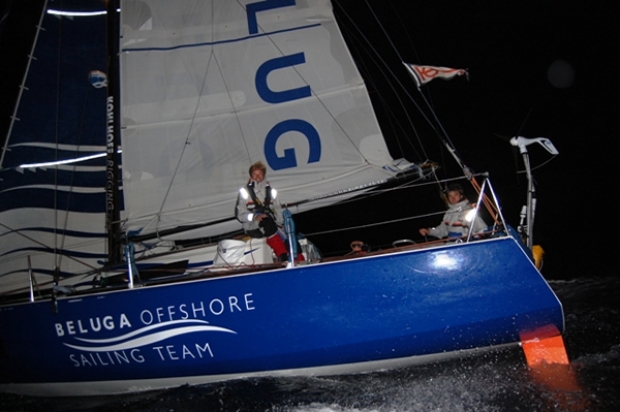Indian Ocean match race concludes
Friday January 16th 2009, Author: OIlie Dewar, Location: United Kingdom
At 03:01:37 local time on Friday (14:01:37GMT Thursday), Boris Herrmann and Felix Oehme crossed the finish line in Wellington, New Zealand, on their Class 40
Beluga Racer, taking first place in Leg 2 of the Portimão Global Ocean Race. The victorious German duo sailed 6,900 miles through the Southern Ocean from Cape Town, South Africa, starting on 14 December, taking 32 days 3 hours 31 minutes and 37 seconds to complete the course at an average speed of 8.93 knots.
In the three days before crossing the finish line, second place Desafio Cabo de Hornos with Chilean duo, Felipe Cubillos and José Muñoz made huge gains on the lead held by Herrmann and Oehme.
“We were definitely concerned about Felipe and José,” admitted the German skipper shortly after docking at Queens Wharf, Wellington. “We were quite upset as we broke a big spinnaker at the beginning of Leg 2 and three days ago, we broke the spare.” Approaching the coast of South Island with the prospect of light south-westerly breeze triggered frantic activity on Beluga Racer. “So, with a light patch in front of us we had to repair the sail. It was a very big job, it took six hours.” However, the repair failed to hold. “After 12 hours of sailing, it began to disintegrate and a big hole appeared,” continued Herrmann. “So we were just both looking up at the spinnaker, really concerned it would go completely. If that sail had fallen to pieces, the Chileans would have overtaken us easily.”
At midnight on Wednesday, Beluga Racer rounded Cape Farewell at the northern tip of South Island and Beluga Racer found an extra gear: “We had the best sailing day ever,” recalls Herrmann. “At Cape Farewell we had very good breeze and flat water – like sailing on Lake Garda – with only 30 metres depth!” Having spent 32 days in the Southern Ocean where depth recordings usually contain four digits and the sea colour often ranges from dark grey, to a slightly less dark grey, this change was a revelation. “It was a really beautiful, bright colour. The sun was shining and it was really warm, really amazing.”
The outstanding sailing Herrmann has delivered single-handed is well known, but the additional success double-handed and his ability to hold the lead in Leg 2 for 18 days results from a perfect sailing partnership with his co-skipper. “We never stress each other out or argue and it’s working out really well,” he explained. “Felix never makes mistakes, he is always pushing the right amount. He’s never too lazy, never too hyper and you know how it can be really annoying if your team mate is upset all the time. We can rely on each other completely. If I’m at the top of the mast, I just have to shout one word down to the deck and he knows what to do.”
Hurrying through the media interviews, the German duo quickly piled into a RIB and set off towards the start line at high-speed to welcome their archrivals. Just over three hours after Beluga Racer crossed the line, Felipe Cubillos and José Muñoz sailed their bright red Class 40, Desafio Cabo de Hornos to second place in Leg 2 at 17:32:20 GMT (06:32:20 local) after 32 days 7 hours 2 minutes and 20 seconds at sea. The German duo swiftly boarded the Chilean Class 40 to congratulate Cubillos and Muñoz after Desafio Cabo de Hornos crossed the finish line and headed at best speed to Queens Wharf.
“I like these German guys,” admitted Cubillos shortly after stepping ashore. “I’d like them a lot more if they were three and a half hours slower. In fact, I would love them!” At the finish of Leg 1, Desafio Cabo de Hornos was only three hours behind Beluga Racer across the finish line after almost 7,000 miles of racing and this offshore conflict has a great appeal for the yachtsmen: “They are great sailors and I think for both teams it was good to have this kind of close competition,” continued Cubillos. “The two boats out there in the middle of the ocean, fighting each other. We sailed as hard as we could, but you can always do better.” For the Chilean Class 40, the turning point in Leg 2 was 10 January with Desafio Cabo de Hornos stalling in a high pressure system off Tasmania while the Germans kept further south. “I think we made maybe two bad decisions and they took a lead of 136 miles. We cut down the distance between us, but we ran out of time. A couple of days more and maybe the result would be different. But Boris and Felix are good, very good.”
Miraculously, the one year-old, Guillaume Verdier-designed Class 40 crossed the Indian Ocean without sustaining damage: “We’re in very good shape and we didn’t break anything,” reports Cubillos. “All our sails are intact and the boat is perfect. Although we pushed the boat and did 25 knots one night, in general we took care her. I would say we are 100 percent ready for the next leg.” With a spirit of sportsmanship and a high level of competition and hard sailing that are becoming synonymous with the Portimão Global Ocean Race and a signature of Class 40, the remaining half of this circumnavigation will deliver some extraordinary racing.









Latest Comments
Add a comment - Members log in